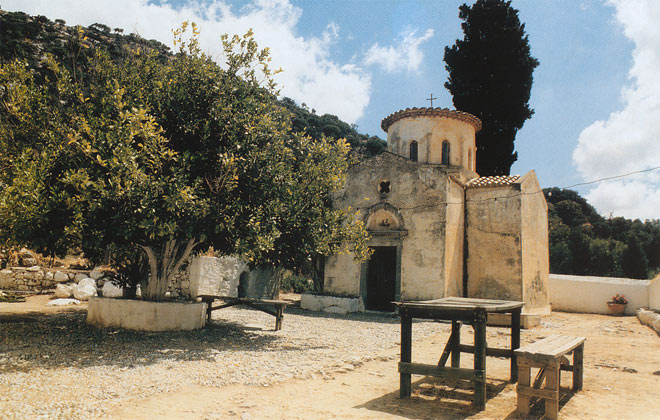This temple used to be the Katholikon of a monastery. The remains of the monastic cells date back to the 19th century during the Venetian period of Laurentius Maripero in accordance with the Ducal Archive of Handakas (1368). The architectural style is that of a cross on a dome and the western part of the monastery is bigger in length. Based on the interior mural paintings, this monument is believed to have been built in the second half of the 14th century.
The iconography inside the monastery is representative of the Byzantine tradition. There is a representation of Christ on the Dome, while mural representations of the Prophets and the Evangelists can also be seen inside the temple. On the arch you can see a drawing of Virgin Mary surrounded by angels and below that there is a representation of the Holy Communion of the Apostles and the officiating hierarchs. On the Eastern side of the building there is a drawing of Jesus’ birth, the Hypapante (“meeting” in Greek), Joseph’s dream, the flight into Egypt and other fragmentarily preserved scenes from the life of Jesus. On the Southern part, depictions include the resurrection of Lazarus, the entrance into Jerusalem and several other representations of Jesus’ life. On the Western part there is a representation of the Passion of Christ: The betrayal of Judas, Jesus’ trial presided by Pilate, Peter’s denial, Jesus on the cross, the mocking of Jesus and his crucifixion, the Myrrhbearers at the tomb, the assumption etc. Finally, in the arch of the northern part there are some faded representations of the life of Virgin Mary and the miracles (the healing of the blind, the healing of the paralyzed, Jesus and the Samaritan woman).
The elevated artistic level of the paintings found inside this temple is the reason why Panagia Gouverniotisa monastery is classified among the most important monuments of the Paleological period of Crete. Also, all the frescoes decorating the walls help us understand better the different kinds of artistic influences observed in the monastery. The movement of realism, the wide thematology of the paintings, the unusual order of the depiction of scenes, the emphasis on the life of Virgin Mary and the detailed work are all characteristics that connect this monument to the iconography of the Macedonean School.



